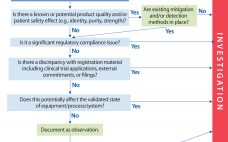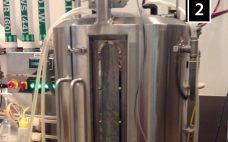After many years of development, gene therapy is beginning to deliver on its promises in the clinic, in some cases with spectacular outputs. Those clinical successes also have led to an influx of funding and engagement from large pharmaceutical companies, thereby bringing the required financial support and expertise for late-stage clinical developments and product commercialization. Although many initial studies were confined to small patient groups and focused on a range of rare monogenetic diseases, new approaches to gene editing have…
2017
Process Needs of Antibody Fragments and Bispecifics: A Discussion with Jonathan Royce of GE Healthcare
Although the number of bispecific antibodies approved so far (two) and antibody fragments either approved or with an investigational new drug (IND) filed (‚ąľ20, both antigen-binding and variable) are far below the number of approved and candidate monoclonal antibodies (MAbs), research in both fragments and bispecifics continues to look promising. And as Jonathan Royce, business leader for chromatography resins at GE Healthcare, discusses here, both offer specific therapeutic advantages over MAbs. But manufacturers should be aware that their diverse structures…
Controlling Glycosylation in Fusion Protein Manufacturing to Generate Potent Biobetters
The pipelines of pharmaceutical companies are full of biological drugs. Many of them are innovative therapeutic proteins, but a growing number represent biosimilars and biobetters (Figure 1) (1). Biobetters typically are defined as being ‚Äúbased on innovative biologics but with improved properties‚ÄĚ (2). Their development benefits from known therapeutic approaches and mechanisms of action resulting in low risk, fast paths to the clinic and thus lower costs. Superiority is achieved through extended half-life (t1/2), improved efficacy, and reduced immunogenicity or…
Developments in Antibody‚ÄďDrug Conjugates: A Discussion with Thomas Ryll of ImmunoGen
As a major class of emerging therapies, antibody-drug conjugates (ADCs) already have gained the attention of biopharmaceutical researchers and manufacturers because they combine both the precision of monoclonal antibodies and the potency of highly potent drug compounds. A few ADCs already have entered the market, but many more candidates are progressing through industry pipelines. Platform processes are not yet universal (and it remains to be seen whether they ever will be), but major ADC developers are establishing their own with…
September From the Editor
BioProcess International and the BPI Conference are a bit like twins in that they were born together, but one arrived just ahead of the other. The magazine evolved from a close relationship between its founders and the staff of ‚ÄúIBC Life Sciences‚ÄĚ just after the turn of the century. And as we got the publication going back in 2002‚Äď2003, we realized that four separate IBC meetings could come together as one under its banner and now-familiar logo. We‚Äôve been colleagues…
September Spotlight
‚ÄúSmaller Is Better‚ÄĚ Chemical Bioproduction Ramon Gonzalez, professor of chemical and biomolecular engineering at Rice University and director of its Advanced Biomanufacturing Initiative (iBIO), believes that ‚Äúwaste‚ÄĚ methane represents an opportunity for biomanufacturing that should not be missed. Instead of getting burned off, methane could and should generate profits. With advancements in biomanufacturing, wild-type or genetically modified bacteria can turn carbon-rich methane into valuable chemicals ‚ÄĒ producing them at smaller scales in more environmentally friendly processes than those of classical…
Transforming Deviation Management
All biopharmaceutical companies espouse a belief in scientific, risk-based approaches. However, with respect to deviation management systems (DMSs), the industry is falling short of that promise. By and large, companies still use a small-molecule pharmaceutical compliance model that dates back to the 1980s, based on the strategy that all deviations are created equal and require 30-day closure. Most bioprocessors still hold to a default 30-day rule, even though there is no specific regulatory requirement for that time frame. Major or…
China’s Biopharmaceutical Companies Target Global Markets
Global perspectives of China as a major biopharmaceutical supplier have changed over the past decade. In 2008, BioPlan Associates completed its first analysis and directory of the top 60 biopharmaceutical facilities in China (1). Based on findings from our study titled Advances in Biopharmaceutical Technology in China (2), we found that China clearly held the image of a low quality manufacturer of biogeneric products almost exclusively for its domestic market. Further, concerns over intellectual property protection, contracting problems, and management…
Change Happens: Technical and Regulatory Considerations for Pharmaceutical Product Lifecycle Management (CMC Forum)
In the current global regulatory environment, management and implementation of postapproval CMC changes often can be unpredictable and inefficient. Timelines for change approval can vary from months to years, depending on regional regulatory procedures. Therefore, the challenge in postapproval lifecycle management is to maintain a constant supply of high-quality product while supporting innovation and continual improvement. This was the premise of the CASSS Chemistry, Manufacturing, and Controls (CMC) Strategy Forum held in Gaithersburg, MD, on 20‚Äď21 July 2016. The forum…
The Unican Concept: Engineering Dual Capability into Single-Use Vessels
Use of disposable bioreactors in the biopharmaceutical industry has increased gradually over the past several years in pilot, clinical, and production scale facilities (1‚Äď4). Reduced time to market in today‚Äôs drug industry has created a need for cost-effective development and production strategies as well as manufacturing flexibility. When compared with traditional stainless steel equipment, disposable bioreactor and mixing systems have smaller space requirements, are portable, and come presterilized to eliminate the need for preuse sterilization procedures such as steam-in-place (SIP).…










